The Elefant (German for “Elephant”) Sd.Kfz.184 was a 70 ton panzerjäger (tank hunter) used by the Germans during WWII. It was armed with a 88mm Pak 43/2 L/71 main gun and a 7.92 mm MG 34 hull machine gun.
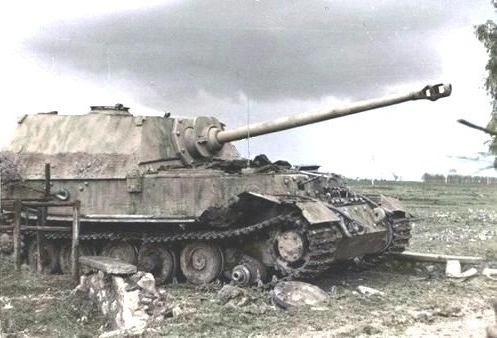
On 21 May 1942, Henschel and Porsche submitted designs for a 45-ton heavy tank mounting a high velocity 88mm Kwk 36 L/56 gun which was derived from the 88mm Flak 37 AA gun. Both the Henschel and Porsche prototype tanks had the same turret fitted which was designed and supplied by Krupp.
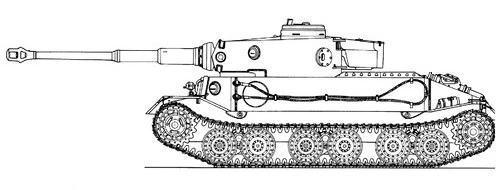
Dr. Ferdinand Porsche designed and produced the VK 45.01 (P) prototype which was powered by twin V-10 air cooled gasoline Porsche Type 101 engines that were mounted at the rear of the tank. Each of the twin engines drove a separate generator, one for each side of the tank, which powered two electric motors, one powering each track from the rear drive sprocket. The engines and drive train were new and an unorthodox design for a tank which would have greatly conserved fuel but due to being under developed were prone to break down or require frequent maintenance. At the time, it was also difficult to obtain the amounts of copper required to mass produce vehicles with the electric drives. Porsche also developed its spring rod roller carriage; 6 road wheels, each road wheel formed of an inner and outer paired wheel per axle. The six paired road wheels were divided into three 2-axle bogies per side, for a total of 12 individual wheels, 6 road wheels per axle, in 3 bogies. Porsche produced 100 chassis in preparation for mass production and 9 were used for the prototypes.
During test trails at Berka, Germany, the VK 45.01 (P) competed against the Henschel identically-armed and more conventional VK 45.01 (H) H1 prototype which proved to be superior. In October 1942, the Tiger commission met to evaluate the two entries. The Henschel prototype was adopted for mass production and became the feared Tiger tank. From March to May 1943, 91 VK 45.01 (P) chassis were converted to the Panzerjäger Tiger (P) “Ferdinand”, Sd.Kfz.184.
Schwere Panzerjäger-Regiment 656 consisting of s.Pz.Jg.Abt. 653 and s.Pz.Jg.Abt. 654 received 89 of the new Panzerjäger Ferdinands. The Ferdinands were first used in combat on the eastern front at Kursk in July-August 1943 and during the campaign they took heavy losses against Soviet aircraft, heavy artillery, anti-tank guns, mines and trenches.
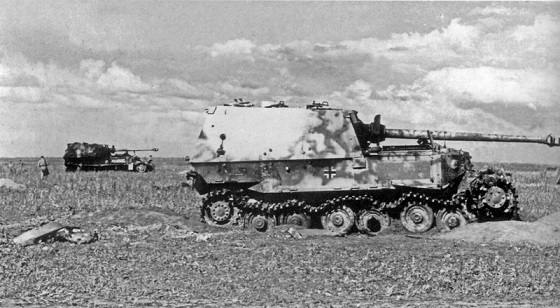
Film: Elephant Panzer in Action
Starting in December 1943, 50 surviving Ferdinands from Kursk were sent piecemeal to Nibelungenwerke at St. Valentine for rebuild and upgrade but only 48 were rebuilt. Upgrade work on the first 8 Ferdinands began on 19 January 1944.
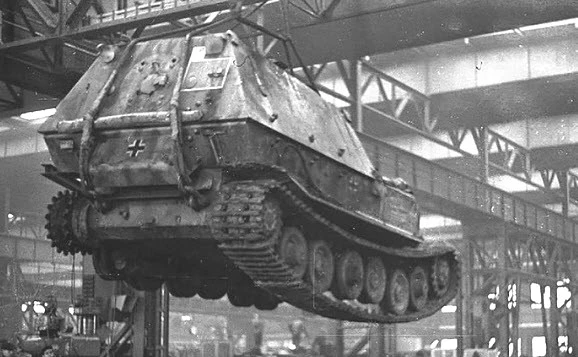
In November 1943, Hilter ordered the name to be changed from “Ferdinand” to “Elefant”. The OKH (German Army High Command) issued orders on 1 and 27 February 1944 which were received by the field units on 1 May 1944 but actually came into effect on May 19th. It was not linked specifically to the upgrade program but was just a coincidence. Technically, for five months since the upgrades began the Sd.Kfz. 184’s were still being called “Ferdinands” by the field units.
During the upgrade, the following improvements were made:
- Field modified Ferdinands with mixed Otto and Maybach engines were all replaced with Maybach HL 120 TRMs.
- Two five litter carbon dioxide remote operated fire extinguishers were installed in the engine compartment.
- The internal intercom was improved by adding a mechanical signalization system between the commander and driver.
- A 30mm armored plate was welded to the driving compartment floor
- An additional ammunition bay was added to increase the number of rounds carried inside from 50 to 55.
- A MG 34 machine gun position was fitted to the right side of the driving compartment glacis.
- A round commander’s cupola (from StuG III) replaced the rectangular hatch on top of the fighting compartment.
- The narrow 600mm tracks were replaced with wider redesigned 640mm tracks.
- The gun mantlet shield (an earlier field modification) was reversed so the seams and bolts faced forward.
- The engine louver covers were redesigned and reinforced.
- An additional sunshade was added to the driver’s periscope.
- All exterior tools and spare tracks were relocated to the rear and more external stowage racks were added.
- Reinforcement brackets were added to the fenders.
- The headlight assemblies were removed from the front hull.
- Zimmerit was applied to the vertical and lower sections of the hull.
The upgrade increased the weight from 65 to 70 tons.
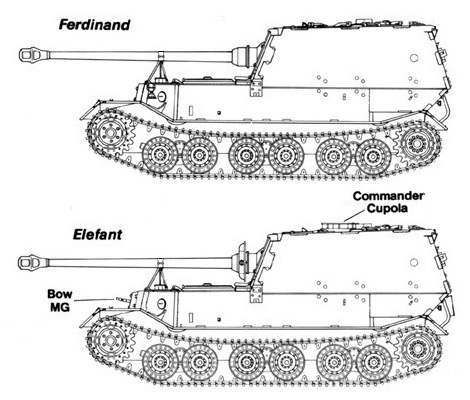
ITALY
Most of the Ferdinands/Elefants in Italy did not have tactical numbers displayed. The tactical numbers displayed underlined were obtained from a number of sources and it is the possible that some or all are incorrect.
On 22 January 1944, the US and British executed Operation Shingle the landings at Anizo to bypass the then stalemated Gustav Line. The town of Cisterna about 14 miles (22.5 km) northeast of Anizo became a main assembly point for German units opposing the US units in the Anizo beachhead.
On 30 January 1944, based on incorrect Intel, the US 3rd Infantry Division spearheaded by three US Ranger battalions (Darby’s Rangers) launched an attack to capture Cisterna. The Germans cut off, surrounded and wiped out the 1st and 3rd Ranger battalions which foiled the attack and it was aborted. The US units retreated and dug in.
These movies portrayed this failed attack:
- “Darby’s Rangers” 1958 starring James Garner
- “Anizo” 1968 starring Robert Mitchum and Peter Falk
As part of the response to the Allied landings at Anizo, the German High Command ordered the schwere Panzerjäger-Regiment 656 to send Sturmpanzer-Abteilung 216 (Brummbärs) and a kompanie of upgraded Ferdinands to Italy to counter the Allied forces. By February 15, 1./s.Pz.Jg.Abt. 653 commanded by Oberleutenant Hellmut Ulbricht received only the first 11 Ferdinand upgrades out of the required 14 for a Kompanie. The last three needed more work to become operational and would not be ready in time so it was decided to send what was available. The kompanie detrained at Ficulle, Italy and road marched to Rome. Between February 16 and 24, 1./s.Pz.Jg.Abt. 653 reached just north of Rome and went to an assembly area in Genzano di Roma near Lake Nemi. The kompanie was attached to sPzAbt. 508 and on February 27 were assigned to the Hermann Goring Panzer-Division becoming an improvised armored force of the LXXVI Panzer Corps. 1./s.Pz.Jg.Abt. 653 then moved to an assembly area north of Cisterna.
1./s.Pz.Jg.Abt. 653 unit structure in Italy also included were a full Maintenance platoon with 5 Famos, a Famo 9/1 with crane and a Fries gantry crane. A Zug is a Platoon in German.
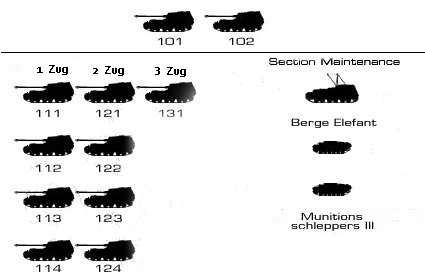
From 29 February to 3 March 1944, the Germans launched an offensive against the allies with the objective of reducing the Anizo beachhead where two columns attacked from Cisterna. The HG Panzer Division supported by sPzAbt. 508 attacked southwest along the Cisterna-Netunno road towards the town of Isola Bella (“beautiful island” in Italian) which was occupied by G Company, 15th infantry regiment, US 3rd Infantry Division supported by M10s of B company, US 601st TD battalion. The other column made up of the 715 Infanterie-Division supported by the 26 Panzer-Division and Sturmpanzer-Abteilung 216 attacked southwest along the Cisterna-Aprilia road (north of the Cisterna-Netunno road) towards Ponte Rotto (“Broken Bridge” in Italian). Southwest of Ponte Rotto was the 7th infantry regiment, US 3rd infantry Division supported by the US 751st Tank battalion. During this period, the weather was mostly overcast and heavy rains which made the fields and roads very muddy. The US 3rd infantry Division repelled three German divisions forcing the German units to return to their starting positions and the front line became a stalemate for the next few months.
February 29 Map

On March 1, Fedinand 114 (Commander: Unteroffizier Werner Kühl) while leading a column from Kampfgruppe Stein (1st kompanie sPzAbt. 508 Tiger Is and HG troops) got bogged down on a wet road verge when trying to turn around before a small destroyed bridge blocking its way. The Fedinand slid off the Cisterna-Netunno road near Isola Bella and badly bent a swing arm on one of the bogey units thereby jamming the wheel and track which immobilized it in the mire. After recovery efforts by an 508 Tiger failed, it came under heavy mortar and artillery fire and the recovery effort was aborted with the Tiger also lost in the process. The Ferdinand then had its hull side penetrated by a US shell wounding the loader and then the crew abandoned it. Another recovery attempt that night also failed where Kühl was wounded in the shoulder by fragments from a nearby exploding shell. He died the following day from his wound.
This aerial photo of the battle area was probably taken sometime after the war. In the foreground are the ruins of Isola Bella and in the upper left corner of the photo is the town of Cisterna. The Cisterna-Netunno road can be seen down the right side of the photo with a small red “X” marking the bridge nearest to Isola Bella and which was destroyed during the battle.

The two pillars at the crossroads at Isola Bella still stand today. To the right is a close up of the plaque at the base of the left pillar.

US Troops inspecting the destroyed Ferdinand some days later. The ruin buildings in the background is Isola Bella.

This photo shows Fedinand 114 after US engineers pushed it off road onto its back.
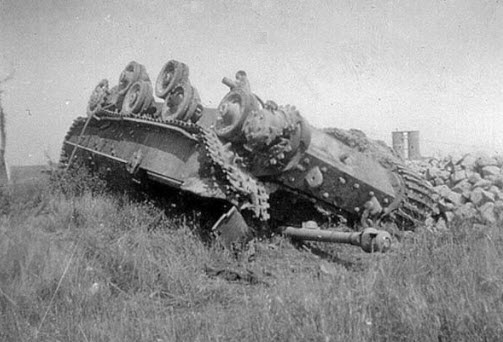
The 508 Tiger that was lost in the recovery attempt is seen nearby.
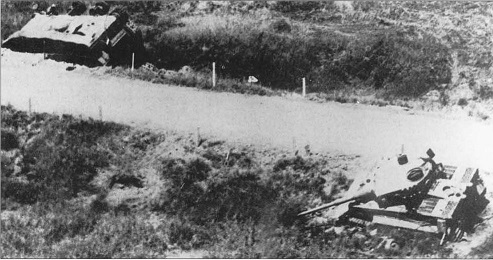
This is a segment from the US 601st TD Battalion After Action report for March 1944. M10s of the 601st B company claimed credit for the knocked out Ferdinand.

Audie Leon Murphy belonged to Company B, 1st Battalion, 15th Infantry Regiment of the US 3rd Infantry Division which was located southeast of Isola Bella. On March 2 while taking shelter from the weather in an abandoned farmhouse, staff sergeant Murphy and his platoon killed the crew of a passing panzer. He then crawled out alone close enough to destroy the panzer with rifle grenades and for this action he received the Bronze Star with “V” device. This event was portrayed in the 1955 movie “To Hell and Back” starring Audie himself.
Movie CLIP: To Hell and Back
On March 2, Ferdinand 131 (Commander: Feldwebel Gustav Koss) while advancing southwest along an unimproved road ran over a mine and was disabled. It was most likely the Cisterna-Aprilia road somewhere near Ponte Rotto which is the only tree lined road in the area even to this day. The Berge-Ferdinand attempted to tow the disabled Ferdinand while under heavy US artillery fire but the recovery had to be abandoned. Ulbricht, his driver and another crewman returned to the site later that night and blew up the Ferdinand. Some sources has incorrectly captioned this Ferdinand as being Kühl’s.
Note the bag hanging off the rear of the Ferdinand.

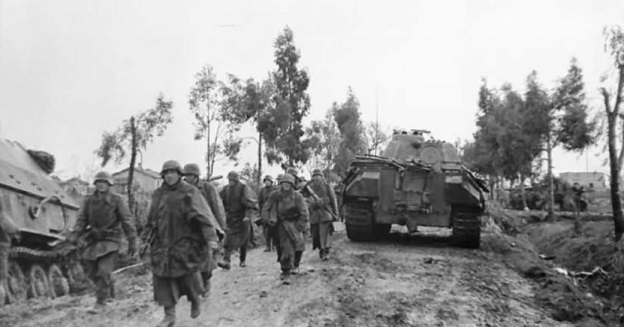
Ferdinand 111 (Commander: Leutnant Werner Haberland) while turning onto a main road from a field access road also ran over a mine and was disabled. This Ferdinand was also located along the Cisterna-Aprilia road facing north. Later this Ferdinand was recovered and the damage was repaired.
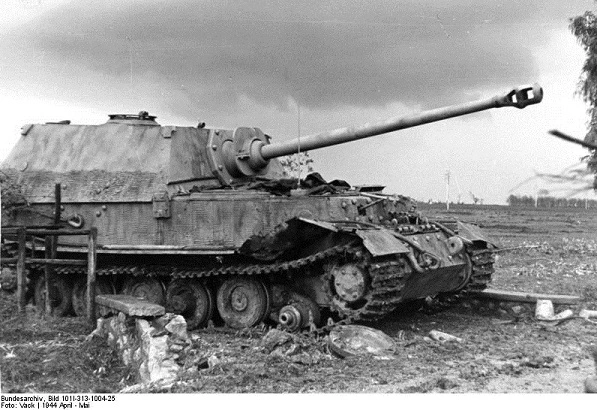
Panther D I02 belonged to I./PzRegt. 4 which was attached to the 26. Panzer-Division.
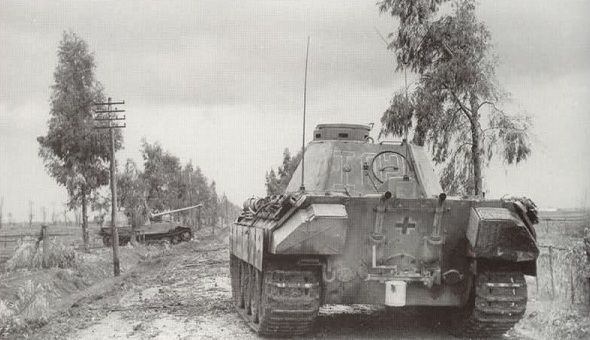
In this photo, a PzKpfw III is passing Ferdinand 111.
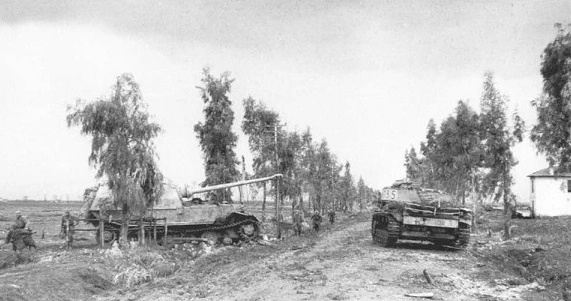
The rear of a Panther can barely be seen down the road.
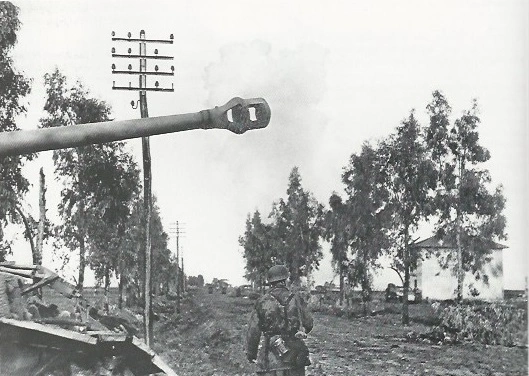
This is the left side of the of Ferdinand 111. Note the Panther on the road.

After losing two and one Ferdinand damaged in a couple of days (3 out of 11 is 27%), 1./s.Pz.Jg.Abt. 653 was moved to an assembly area behind the front lines somewhere between Cisterna and Velletri to be held in reserve until mid May 1944.
This is supposedly Ferdinand 111 after it was later repaired and seen here during a test drive. The crew has liberated a small wine cask from a village somewhere near Cisterna in March. This crew really knows how to relax.
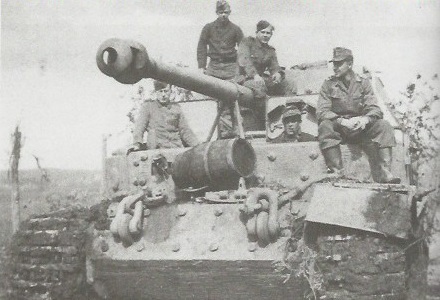
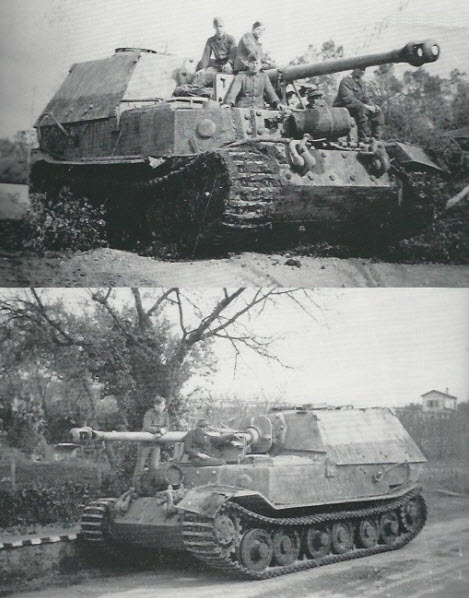
On 1 April 1944, Hellmut Ulbricht was promoted to Hauptmann (Captain).
Elefant 102 Fgst. 150071 began as Ferdinand number 633 of 2./s.Pz.Jg.Abt. 654 commnded by Feldwebel Meyer at Kursk in 1943. It is possible Ferdinand 633 suffered an engine fire while at Kursk. Records indicates that 633 was in maintenance for 9 days. The two gasoline engines were exchanged, idler arms replaced and the cooling system was overhauled and cleaned. The floor ventilators were replaced and the alternator was re-fasten.
On 23 May 1944, Operation Buffalo the allied breakout of the Anzio beachhead began. The remaining nine Elefants of 1./s.Pz.Jg.Abt. 653 were lined up in prepared positions 2 km (1.2 miles) behind the front lines along the Via Appia waiting for the enemy. The Via Appia is an ancient roman road (Highway 7) which runs from the southeast through Cisterna then heads northwest towards Velletri and Rome. Elefant 102 was probably positioned in or around Cisterna.
On May 24-25, US air strikes and heavy artillery with advancing US forces forced the elefants to either be abandoned or withdraw from their positions. Three infantry regiments (30th,7th and 15th) of the US 3rd Infantry Division supported by the US 751st Tank Battalion and 601st Tank Destroyer Battalion attacked Cisterna and captured the totally destroyed town on the morning of May 25th. The 30th regiment then attacked northeast along the Cisterna-Cori road towards Cori. The 15th regiment was south of the 30th regiment advanced northeast parallel to the 30th. To the north of the US 3rd Infantry Division was CCB of the 13th Armored Regiment, US 1st Armored Division which advanced northeast over the Colle di Torrechia hills then swinged north towards Giulianello.
This is a segment from the After Action Report of the 751st Tank Battalion for May 1944. Company D was the light tank company equipped with M5A1 Stuarts.

The After action report of the US 601st TD Battalion only states they fired upon by enemy infantry held strong points, MGs and AT guns. The history of the US 3rd Infantry Division only mentions encountering Tigers and SPs during the breakout. Some of the SPs could been Elefants.
May 23-25 Map
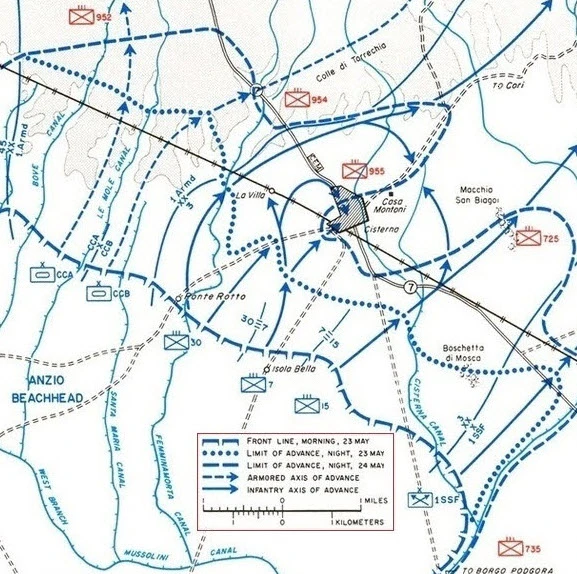
On May 24, Elefant 102 became disabled by an engine fire somewhere along the Cisterna-Cori road northeast of Cisterna either while withdrawing or maybe leading a counter attack. The crew booby trapped the Elefant with grenades strung up inside before abandoning it and withdrew from the area. Most sources state that Ulbricht commanded Elefant 102 but some sources state Ulbricht commanded Elefant 101.
Abandoned Elefant 102 being examined by US troops.


On May 25 during the Allies breakout of the Anizo beachhead, Elefant 113 (Commander: Feldwebel Edmund Roos) was hit in the track by US artillery fire. The crew abandoned it and the loader was killed while bailing out.

On June 4, the Allies liberated Rome but the news was quickly overshadowed by the Normandy landings in France two days later.
On June 6, Elefant 123 (Commander: Obergefreiter Lassig) was destroyed by allied aircraft somewhere along or close to the Via Aurelia. The Via Aurellia was an historical Roman road which connects Rome to the Tyrrhenian Sea, then follows the Tuscan coast up to Pisae (Pisa today) where it ends. Today, the Via Aurellia is a major highway and the areas along it are built up. Aerial rockets or bombs could not flip an Elefant onto its side without creating large craters on the road. Allied engineers probably bulldozed the Elefant onto its side to clear the road.


Would a knocked out Elefant be a good playhouse for children?


During the Allies breakout (May 23-25), Elefant 121 (Commander: Oberleutenant Willi Grupe and gunner Albert Riecker) knocked out four sherman tanks probably of the US 751st Tank Battalion. But Grupe’s glory was short lived due to a tragic accident.
On June 7 while retreating north of Rome between Monte Fiascone and Oriveto, Grupe’s Elefant was having engine trouble and was running on one engine (the Elefant had two). While enroute to the maintenance unit, they came upon an ancient Roman stone and sand bridge which crossed a stream with 8-10 meter embankments on both sides. Grope ordered the driver to stop at the foot of the bridge and surveyed the situation. A sign indicated the bridge capacity was at 12 tons or more and Grupe spotted Elefant tracks going across the bridge. Assuming it was safe, Grupe ordered the driver to proceed across the bridge (later they found out the tracks were made by the lighter Berge-Elefant.)
Halfway across, the bridge collapsed from the weight of the Elefant and it tumbled to the right along with the embankment and gravel. The Elefant landed almost upside down on the bottom. While falling over the edge, Grupe ducked inside and was crushed to death when the main gun sheared loose. The driver was unharmed while three crewmen riding outside were able to jump off as it went over and the loader was slightly injured on landing. On Ulbricht’s orders, Grupe’s body was recovered and the Elefant was blown up.
This photo is captioned as being Willi Grupe’s Elefant. Only the numbers “12” can barely be seen on the fighting compartment.

This film shows US troops might be examining this Elefant which can be identified by the vines hanging down the rear hull side.
Film Clip: Critical Past – The Italian Campaign in World War II
On June 10, Elefant 122 (Commander: Feldwebel Reinhold Schlab) was knocked by US aircraft near Orvieto. Direct hits on the engine and crew compartments set the Elefant on fire.
These photos were taken by an Oberleutenant from the 715 Infanterie-Division.


This photo gives a view of the fighting compartment.

Also on June 10, due to mechanical problems and the impossibility of recovery Elefant 112 was destroyed by its crew near Ficulle (north of Oriveto). The Germans removed the tracks and road wheels probably to be used as spare parts and it would also made it difficult for the Allies to move the Elefant.


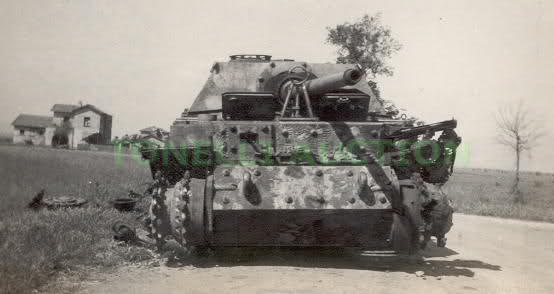
Due to mechanical problems and unable to repair it, the crew destroyed Elefant 124 in Soriano (northeast of Rome and east of Viterbo).

Soriano (today Soriano Nel Cimino) was located near or on the boundary between the US 5th Army and the British 8th Army. On June 9, Soriano was secured by C Troop of the US 91st Cavalry Reconnaissance Squadron, 2nd Corps, US 5th Army (part of Task Force Ellis). The South African 6th Armoured Division and the British 78th Infantry Division were the only commonwealth units around Soriano on that date. Some sources state these photos were taken in July 1944.
On the front hull are the parts of one of its spring rod roller carriage bogies
which probably was removed to be repaired.

This is the view looking down the front from atop of Elefant 124.
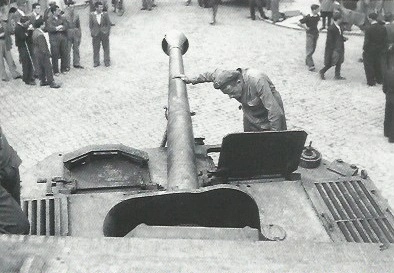
This is the right side of Elefant 124. Note the gap of the removed bogie.

This is the location today. Note the the metal railing on the balcony and the windows on the second floor.


Storefronts would have changed over the the years but not historic buildings. This is the north side of the street and the building on the far right is the Chiesa San Nicola di Bari (Church of St. Nicholas of Bari) along Piazza Vittono Emanuele II. Compare the green arch topped door on the left to the first photo above.

This is the view of the whole street facing East. The church is on the left and the building with the balcony is across the street.
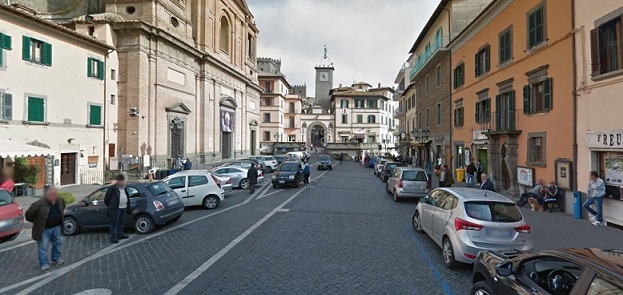
These are two photos of Elefant 101. The Elefant crews were issued Wehrmacht tropical uniforms in mid-May 1944.

This is my close up of the front hull of Elefant 101. The hull MG was removed probably to make room for additional radio(s) and there is a plate over the MG port. Note chalked on the plate the “U” for Ulbricht with number “653” below it and an arrow pointing to the right.
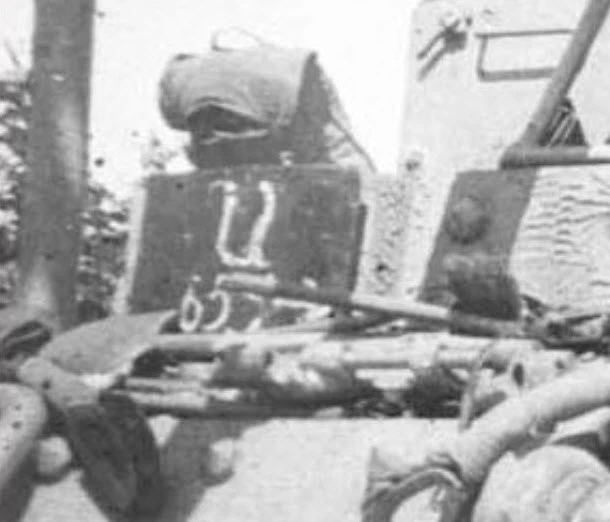
Ulbricht pleaded to high command to transfer 1./s.Pz.Jg.Abt. 653 but the kompanie remained despite its losses and it was only re-named to Kampfgruppe Ulbricht . On June 26, the order was finally recieved for 1./s.Pz.Jg.Abt. 653 to return to Germany but it was not possible to execute the order immediately because the allies were advancing too rapidly. The kompanie retreated through Siena, San Casciano, Impruneta to Florence, Bologna and then through Mantua to Piadena.
On August 2, three Elefants and the one Berge-Elefant were loaded on a train and transported to the Vienna Arsenal for repairs.

This photo taken on August 5 shows only part of the train.

The British REME 687 Heavy Recovery Section (545 was re-designated to 687 in April 1944) retrieved Elefant 102 and transported it to a collection point. This was probably the only unit in the area with the equipment that was capable of moving the heavy beast. The unit had the M19 tank transporter which was the combination of the US M20 Diamond T Model 980 tractor and the M9 trailer.
The following four photos were taken by S/Sgt James Goodall Mcleod who was running the REME workshop at the time.
The British crew fasten a tow cable to the front of Elefant 102.

This is the view of Elefant 102 from the M9 trailer. The background of this photo does not help determining its location.

The Elefant is being winched aboard the M9 trailer.

The M9 trailer maximum load was 45 tons and the Elefant was 25 tons over that. Note how much wider the Elefant is and its tracks overhangs the trailer.

Elefant 102 at collection point
Someone chalked “STAY AWAY. BOOBY TRAP” on the side of the fighting compartment above the 102. On the rear, is a gothic “U” for “Ulbricht”. The most unusual feature of Elefant 102 was two patterns of zimmerit on its hull side with both horizontal and vertical rows.

This is the view of the other side of Elefant 102.
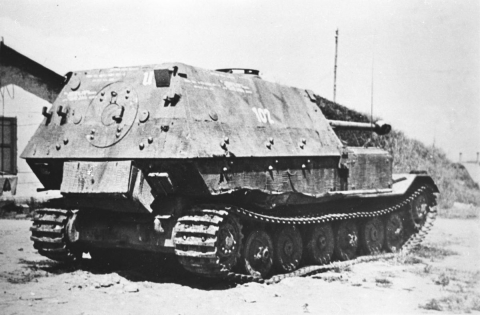
In these photos, the hits to the fighting compartment front armour can be seen. The burnt marks around the shell strikes would indicate they were recieved in Italy. If the hits were received at Kursk they most likely would have been overpainted during the upgrade.
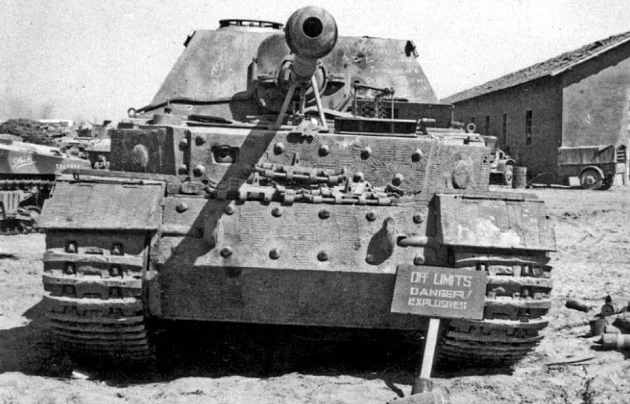

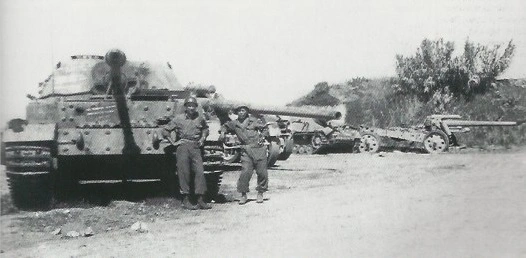

Aberdeen US Army Ordinance Museum
Elefant 102 was shipped to the Aberdeen Proving Grounds, Maryland (in Harford County) USA for testing and Evaluation.
This is Elefant 102 during evaluation testing at APG.

Later it was added to the Aberdeen Museum vehicle collection and sat outside exposed to the weather.
These markings were accurate for an Elefant on the Eastern front but not for the ones that were in Italy.

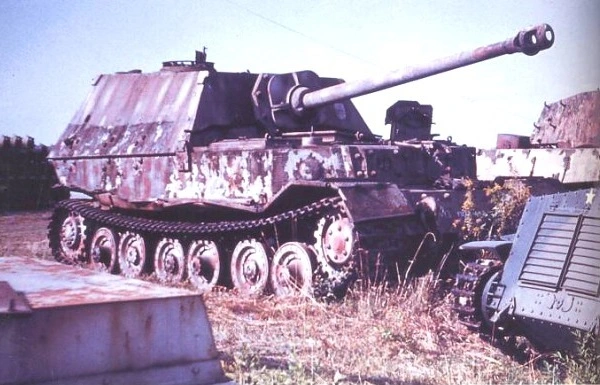
Over the years, it was repainted a couple of times and the zimmerit was removed (what was left of it).
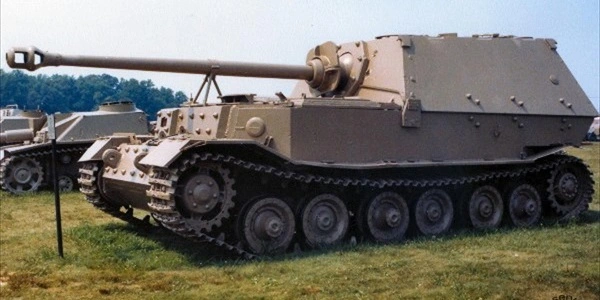

The interior of Elefant 102 rusted over the years being outside and exposed to the weather.
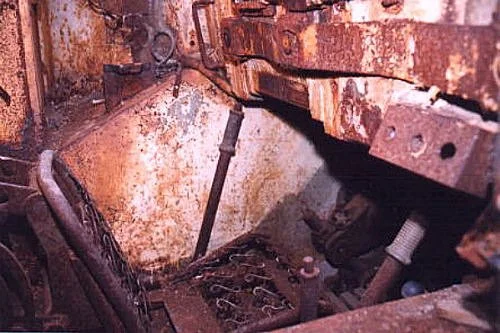

Looking at these photos makes one want to get a Tetanus shot.


Elefant 102 sat at the APG rail-head near Rt 24 for many years after an aborted restoration attempt in Alabama. Note the coat of paint has faded and patches of red primer is showing through.

Walkaround: 2007 Aberdeen US Army Ordinance Museum – Jagdpanzer Elefant
For a long time, the APG Ordnance Museum curator tried to get Elefant 102 moved but with no response from command at APG. The Ordnance Museum had no vehicle moving equipment and depended on other units on the post which had the proper equipment. The post MPs repeatedly complained that civilians were hanging around the Elefant taking pictures and climbing over it.
Finally, the post commandant gave in and ordered an M88A2 Hercules to move the Elefant.

Restoring Elefant 102
Tank Overhaul: Season 2, Episode 2 “Elefant” – First Aired: 11 March 2009
It was restored to display condition in 2007–2008 and the restoration was done in 5 weeks. During restoration, all the fluids were drained from the Elefant. The restoration was not completely accurate for Elefant 102 since they did not recreate the zimmerit.
TV Program: Panzerjäger Tiger (P) Elefant
A fragment from a M61 75mm HE/APC-T (High Explosive/Armor Piercing Capped Tracer) shell was found wedged in the left front sprocket which would indicate the Elefant received a hit from a sherman probably from a long distance. Probably when the sprocket was jammed, the driver burnt out the transmission while trying to get the Elefant to move causing it to catch fire.
The battle damage was highlighted with silver paint.
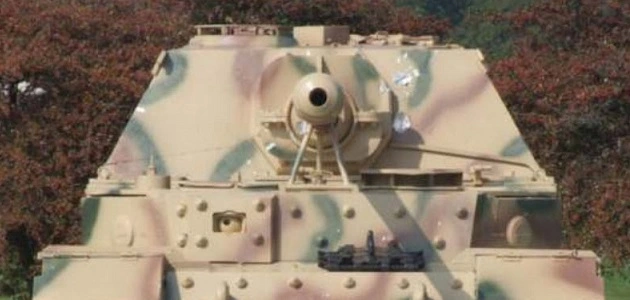
The US Army Ordnance Corps Museum located at APG was moved to Fort Lee, Virginia (outside Petersburg), as a result of the 2005 Base Realignment and Closure (BRAC) Act. The transfer of artifacts from Aberden to Fort Lee began in August 2009 and was completed in late 2011. The museum at Aberdeen was closed in September 2010.
Elefant walk around link: Prime Portal Elefant
Video: Elefant Tank Walkaround
The Elefant was loaned to the Tank Museum at Bovington, Dorset, UK for a special exhibit. It was the first time that an Elefant has ever been seen in the UK.
Video: Elefant Tank Arrives For New Exhibition
BOVINGTON TIGER TANK EXHIBIT 2017 – 2019
The exhibition which began in April 2017 brought every member of the Tiger tank family together in one display for the first time.
Left to Right: Porsche King Tiger, Jagdtiger, Henschel King Tiger, the Elefant and Tiger I 131.
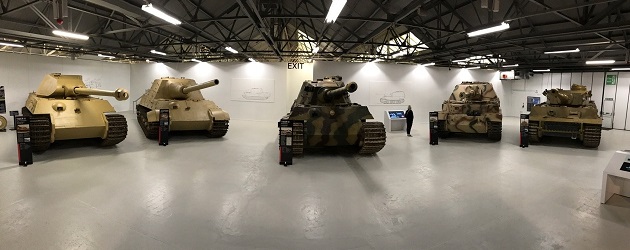
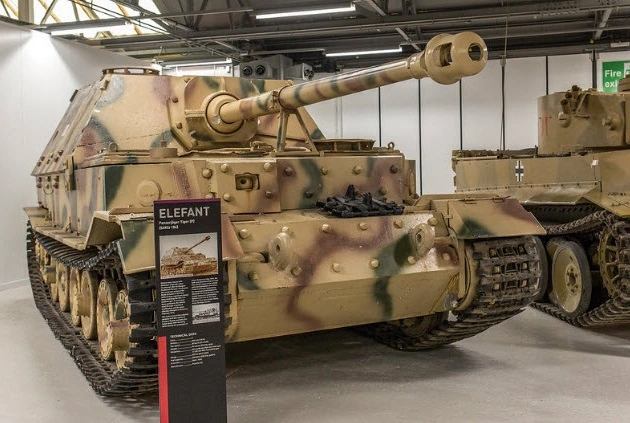
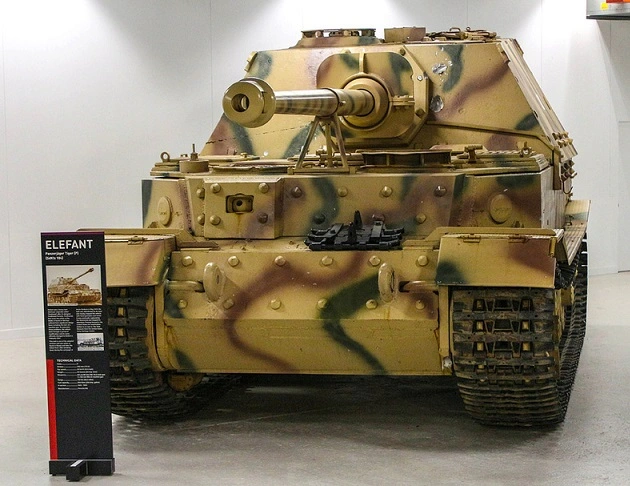
Video: GERMAN TIGER TANK EXHIBITION OPENS
Video: The Tiger Tank Collection Exhibition
Video: Tank Chats #42 Elefant
The exhibition was scheduled to run until the fall of 2018 but due to popular demand it was extended until the fall of 2019. But unfortunately the Elefant had to be returned to the USA early and was on display until 30 January 2019. The empty space left by the Elefant in the exhibition was filled by the T-34 and Sherman Fury tank.
Video: Elefant Tank Returns to the US
After being on display and in the limelight for 21 months, the Elefant was returned to the US Army Ordnance Corps Museum at Fort Lee, Virginia. There is no information of the Elefant’s exact current location but it is probably in storage and not available for public view. Someday it will be on display again.
Model Kits and Accessories
Dragon 6311 1/35 Sd.Kfz. 184 Elefant – 2006
Tamiya 35325 1/35 Sd.Kfz.184 Schwerer Jagdpanzer Elefant – 2012
Zvezda 3659 1/35 German Tank Destroyer Elefant – 2019
Tamiya 32589 1/48 German Heavy Tank Destroyer Elefant – 2017
Gasoline GAS48137K 1/48 Set details panzerjager Elefant Tamiya
Hauler HLX48381 1/48 basic PE set for Elefant Tamiya kit
Hauler HLX48382 1/48 basic PE set for fenders Elefant Tamiya kit
Monroe Perdu Studios Laser Etched 1/48 Scale Zimmerit for Tamiya Elefant Kit (Includes parts for choice of two versions) Website
Tamiya 12671 1/48 zimmerit coating sheet – Elefant: Website
Italeri 7012 1/72 Sd. Kfz. 184 Panzerjäger Elefant – 2007
A future post would cover more detail information on the Ferdinands (and Elefants) on the eastern front and in Germany.

Fascinating write up. Appreciate it. 👍
LikeLiked by 1 person
yay google is my queen assisted me to find this great site!
LikeLike
Some genuinely interesting information, well written and generally user pleasant.
LikeLiked by 1 person
I have been browsing online more than 2 hours today, yet I never found any interesting article like yours. It is pretty worth
enough for me. In my opinion, if all site owners and bloggers made good content as you did, the internet will be much more
useful than ever before.
LikeLiked by 1 person
Hi Mike and thanks for your article.
Can you please contact me off-line.
Asko Karjalainen
LikeLike
Everyone loves it whenever people come together and share opinions.
Great blog, stick with it!
LikeLike
Very energetic article, I enjoyed that bit. Will there be a part 2?
LikeLike
This design is spectacular! You certainly know how to keep a reader entertained.
Between your wit and your videos, I was almost moved to start my own blog (well,
almost…HaHa!) Wonderful job. I really enjoyed what you had to
say, and more than that, how you presented it.
Too cool!
LikeLike
Like!! Great article post.Really thank you! Really Cool.
LikeLike
Outstanding post, you have pointed out some fantastic points, I also conceive this is a very superb website.
LikeLike
Major thanks for the article. Great.
LikeLike
Anzio! Not “Anizo”
LikeLike